Week 7+8 Anatomy Articulation (and tongue muscles)
1/29
Earn XP
Description and Tags
FINAL EXAM https://create.kahoot.it/share/anatomy-of-articulation/e723d846-a040-4b96-9599-7ea86ccb7ef0
Name | Mastery | Learn | Test | Matching | Spaced |
|---|
No study sessions yet.
30 Terms
What 3 parts can the vocal track be divided in?
– Pharynx
– Nasal tract
– Oral tract (tongue, teeth, lips, jaw)
Many different (big and small) structures, muscles and ligaments are involved in the production of speech
What is articulation for speech?
– Process of bringing two or more moveable speech structures together to form the sounds of speech
– In the oral cavity, the undifferentiated buzz produced by the vocal folds (i.e. the source signal) is shaped (manipulated) into phonemes
What’s the source-filter theory of vowel production?
Describes how oral cavity shapes speech
States that a voicing source is generated by vocal folds, routed through vocal tract, and then shaped into sounds of speech
Vocal tract consists of the oral cavity, pharynx, and nasal cavity
This linkage provides the variable resonating cavity that produces sound
Which structures are used to produce sounds of speech?
May be mobile
Tongue, mandible (lower jaw), velum (soft palate) lips, cheeks, pharynx, larynx, and hyoid bone
May be immobile
Teeth, hard palate, alveolar ridge of the maxillae (upper jaw)
What’s the Oral Cavitiy?
Most significant of the cavities
Undergoes most change during speech act
Strongly involved in articulation
Shaped by movements of tongue and mandible
What are the Cavities of the Vocal Tract (5)?
Hard palate - hard roof of the mouth
Rugae - prominent lateral ridges
Median raphe - divides hard palate in half
Velum - soft palate - soft roof of mouth - movable muscle that separates oral and nasal cavities
Uvula - terminus of soft palate
Anterior and posterior faucial pillars - sides of the velum
Palatine tonsils - between faucial pillars
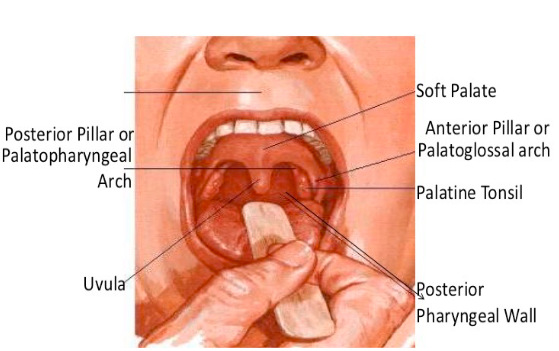
What’s the Buccal cavity?
Plays a role in oral resonance and high level consonant production
Lies lateral to oral cavity between teeth and cheeks
What’s the Pharyngeal cavity (pharynx)?
Shape altered by pharyngeal constrictor muscles, laryngeal elevation and depression
Types of pharyngeal cavities:
Oropharynx - posterior to fauces, above is velum
Laryngopharynx (hypopharynx) - anterior epiglottis, inferior esophagus
Nasopharynx - above the soft palate, contains pharyngeal tonsils (adenoids); lateral wall contains Eustachian tube – aerates the middle ear
Velopharyngeal port (VPP) - opening between oropharynx and nasopharynx

What are the functions of the Nasal cavities?
Warms and humidifies air to protect the lungs
Fine nasal hairs prevent particles from entering lower respiratory tract
Nares - anterior boundary; floor is hard palate (nasal passage)
Nasal choanae - posterior portals connecting nasopharynx and nasal cavities
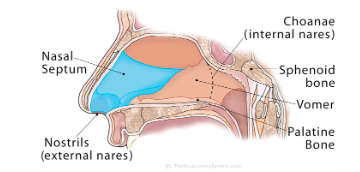
What are the muscles of the face & mouth?
Tongue & mouth muscles
Tongue & Velum
Lips and lip muscles
Movement for speech depends on muscles of face
Important in both facial expression and speech
Richly invested with vascular supply
Have social, cultural and aesthetic value
Mandible muscles
What’s the functions of the lower lip? (6)
Faster and stronger than the upper lip
Achieves a greater velocity and force
Does most of the work in lip closure
Attached to the mandible—a movable articulator
Can accommodate a variety of jaw positions
Resistant to interference
What are the lip muscles? (7)
Obicularis oris - encircle mouth opening
Risourius- superficial - retracts corner of mouth
Buccinator - deep to risourius, retracts corner of mouth, involved in mastication
Levator labii superioris, zygomatic minor, levator labii superioris alaeque nasi - elevate upper lip
Levator anguli oris - draw mouth up and medially
Zygomatic major - elevate and retract angle of the mouth – smiling
Depressor labii inferioris - pull lip down and out

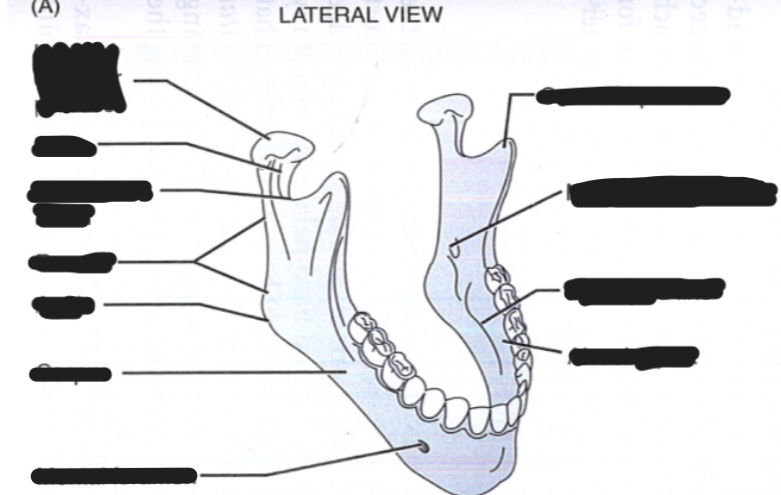
**Label the mandible structure**
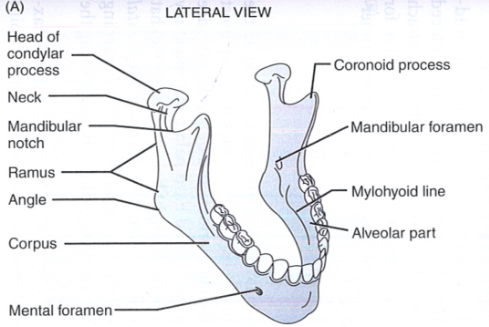
What are the roles of the mandible?
Plays a role in speech (-> jaw opening and closing)
Assists the lips - important supportive role
Changes position for tongue movement
Can tightly close when necessary
Position for speech is one of dynamic tension between antagonists
Mandibular elevator muscles have muscle spindles
Helps to counteract gravity
Plays major role in mastication
Central pattern generator within brainstem
Produces muscular contraction for chewing
Must elevate, grind laterally, and depress
Requires coordinated activation of elevators and depressors
What are the mandibular elevators? (3)
Masseter - elevates mandible
Temporalis - elevates mandible (and retracts)
Medial pterygoid - elevates mandible
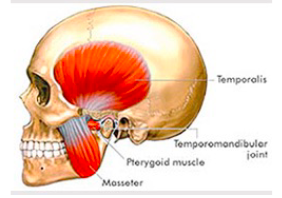
What are the mandibular depressors? (4)'
Digastricus (anterior and posterior - depress mandible
Mylohyoid - depresses mandible if hyoi fixed
Geniohyoid - depresses mandible if hyoid fixed
Platysma
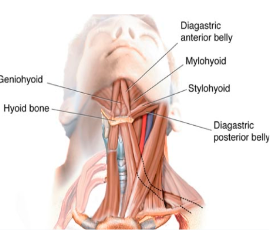
What’s the velum?
Referred to as the soft palate
Performs wide range of movements
Production of most speech sounds
Must remain in a moderately elevated position (for non-nasal sounds)
Non-nasal speech: Velum generally remains closed (velum raised)
Velum is closed for non-nasalized speech
Muscle function for closing: Levator veli palatini (most important one)
Assimilation - some nasal quality to adjacent phonemes
High pressure consonants (fricatives and stops) require greater velopharyngeal closure
Hard and soft palate are endowed with sensors
Uvula is part of the velar structure (hangs from the end of the soft palate)
Hypernasality
excessive nasal resonance due to inadequately closing velum
Hyponasality
absence of nasalized speech in nasal sounds such as /m/ and /n/ due to inadequate velopharyngeal (VP) opening
Nasal tract and velum interaction
Upper part of the nasopharynx merges into the nasal tract and ends at the nose
Biological functions:
Warming of the inhaled air while breathing
All surfaces are covered by mucous membranes

Whats the coupling to the oral tract?
Connection to oropharynx is achieved by lowering the velum -> this process opens the velopharyngeal port (VPP)

What’s Sound propagation in the nasal cavity?
The Nasal tract cannot produce speech sounds by itself -> but in connection to the rest of the vocal tract (connected or not connected) it can alter acoustic properties of speech sounds considerably -> coupling nasal tract is achieved by lowered or raised velum (lowered velum = nasal cavity coupled; raised velum =
nasal cavity not coupled -> not active in speech production)
Nearly no sound energy leaves the nasal tract -> due to small openings plus high damping (reason: the mucous walls)
rather the nasal cavity “draws” energy away from the sounds that are produced and modified in the oral tract
Explain the velum muscles
Muscles of velum compress to elevate the velar structure to completely separate oral and nasal areas -> thus preventing the nasal cavity to be coupled to the oral cavity
Muscles are compressed during most speaking time and when swallowing
Muscles not compressed only when using a few speech sounds in English – nasals
In other languages velum is opened for both nasal phonemes and nasal(ized) vowels
Explain the strucure of the pharynx
The top of the larynx joins with the esophagus at the laryngopharynx (area above the larynx)
The most superior part of the epiglottis marks the beginning of the oropharynx
The area above the velum is the nasopharynx
The pharynx is a four-way crossing: nasal tract, oral tract, larynx and esophagus → Esophagus is used during swallowing and eating (epiglottis closed)

Can the tongue muscle cover almost the complete available articulatory space?
Yes
How’s the tongue divided into
tongue tip (apex)
tongue blade
tongue dorsum
tongue back
tongue root
How are the tongue muscles categorized?
Intrinsic muscles
the origin and insertion are both found inside the tongue structure
responsible for precise articulatory performance
Extrinsic muscles
attachment to structures outside of the tongue (e.g. hyoid bone or styloid process)
tends to move the tongue as a unit
they set the general posture for articulation, with the intrinsic muscles performing the refined perfection of that action.
How are the tongue muscles innervated?
by the hypoglossal nerve (XII)
What are the 3 types of intrinsic muscles and their function, origin & POI?
Superior longitudinal muscle: elevates tongue tip
Inferior longitudinal muscle: depresses tongue tip
Verticalis: pulls tongue down into floor of mouth
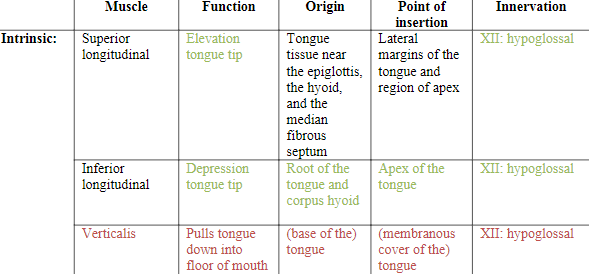
What are the 5 types of extrinsic muscles and their function, origin & POI?
Genioglossus Anterior: Retraction of the tongue
Genioglossus Posterior: Protrusion of the tongue
Hyoglossus: Pulls (side of) tongue down
Styloglossus: Retract and elevate tongue
Palatoglossus: Elevation of the (posterior) tongue (only one innervated by Glossopharyngeal (IX) & Vagus (X) )
